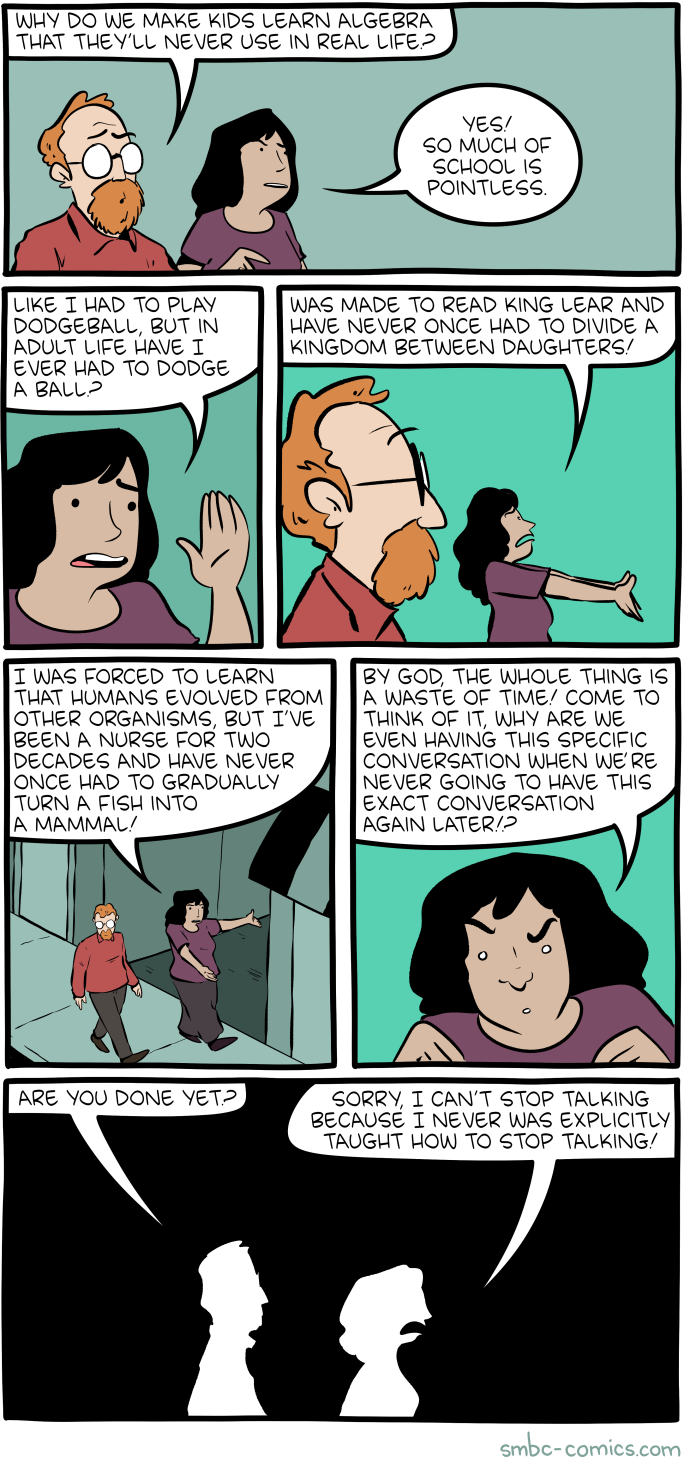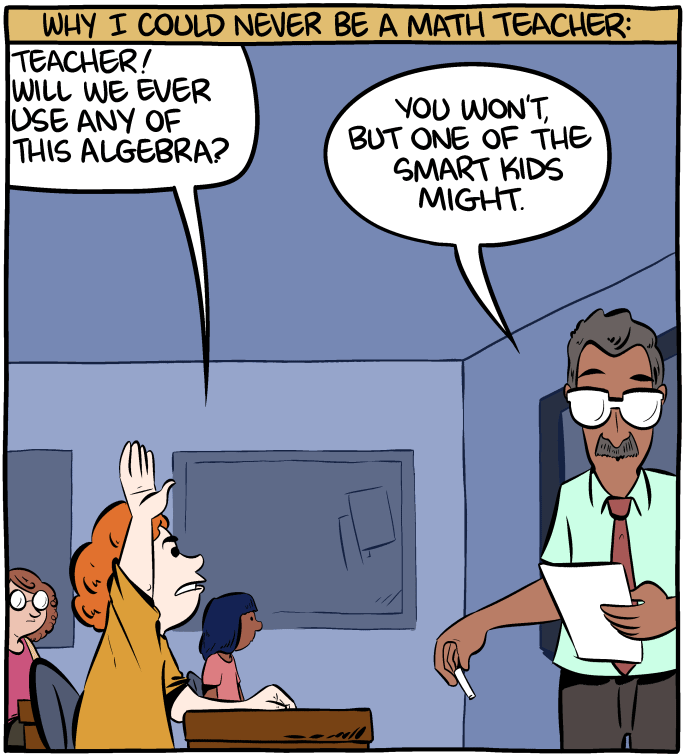Joke’s on you, I sin every day.
deleted by creator
deleted by creator
The smarter kids in your class probably do use them.
Jokes on you, I’m in the bourgeois class and let kids from the working class and professional mangerial class do that kind of homework for me
He said smarter, not wealthier. I’m getting the guillotine.
Nah. I was labeled a dumb kid in high school because I had to work 40 hours a week. I went back to college as an adult and now have a masters in mech Eng.
Went to my high school reunion and the smart kids were largely abject failures. They never really struggled until college, then mostly failed out. I felt bad for them, but not too bad since most of them bullied me.
Sounds like maybe there weren’t the true smart kids. You finished high-school while working a full time job. You were capable and adaptable. Fuck them :)
Thank you for that.
As one of the resident smart kids who went into CompSci and now works as a software engineer, I haven’t touched any of this for a hot minute. I mainly use it for 3D print designs once in a blue moon.
Of course it depends, but for example, it CSS esing functions are based on polinomial or sin waves. If you ever want to understand or perhaps implement and easing function, trigonometry has your back.
But you use things that use them.
like any device that uses graphics
There is at least one smbc for everything

Never really understood people who say they don’t use algebra. I use it very regularly.
I was thinking this myself. sin, cos, tan. Have not used. I have use euler coordinates so thats something but really solve for x is the most advanced thing I have used outside of school. mmmm actually I guess some statistics like stadard deviation.
I recently had to do a two variable equation because I was using a recipe that called for a specific milk fat percentage by mixing cream and milk, and my cream was heavier than what it needed. That was really stretching the limits of what math I remember.
Programmer for 25 years. Only time I have ever used math more complicated than simple multiply/divide was… actually never.
That one time when I copy/pasted a formula for linear interpolation, was still just multiplication and division. And I still have no idea how it works.
I’ve even done OpenGL and graphics programming and still haven’t needed any algebra/trig/etc, although I don’t do complex 3D rendering or physics or anything like that.
I wish I knew how to do cool programming stuff like draw circles and waves and stuff though, but I’ve never seen a tutorial that didn’t go WAY over my head immediately.
Drawing a circle is actually pretty simple! Say we want to draw one with:
- radius r=5
- center C=(0,0)
- 1000 points
The logic would be:
for (let i = 0; i < 1000; i++) { // full circle is made up of 2 * PI angles -> calculate current loop angle const angle = (2 * Math.PI) * (i / 1000) const x = r * Math.cos(angle) const y = r * Math.sin(angle) drawPixel(x, y) }The circle starts being drawn at (5, 0). As y approaches -5, x gets smaller until it hits 0. Then x approaches -5 and y approaches 0, and so on.
That won’t work well ;-) it will draw 1000 pixels whatever the circumference!
A good start though, for sure.
It’s just meant to be a simple example. If someone says other tutorials quickly go over their head, it’s not a good idea to introduce unnecessary concepts to start with.
I use them every day. Making science is rad as fuck.
As opposed to degree as fuck.
Almost made me do a π
I see what you did there.
K
Sin, Cos and Tan were gifted to us by the gods, and it’s solely your fault, if you don’t use them daily in your freetime.
Know any good resources for math-ignorant programmers that teaches how to use those in useful ways?
But you do use them everyday, because the Internet would not work without them.
Doesn’t it? Have we ever tried to rid humanity of this triangle of evil? Un-tan the internet I say! Grab your pitchforks and cos this sin-er to hell!
Jokes on you, basic arm and leg mechanics involves trig
Sad take.
The non-programmer folks upvote this post. I mean, not that I use it for every app, but I have used it in recent memory. SOH-CAH-TOA, bitches!
Back in my day we had to use sentences to remember it
Sill Old Harry Caught A Herring Trawling Off America
Firmly lodged in place forever
Hey, I’m not a programmer, as a real engineer half of my education was in some way related to trig
Alright, alright, you can sit with us cool nerds. 🤓 But on Wednesdays we wear pink fanny packs.
Every day, I use them ever damn day.

For determining the right angle to fuck the sharks from?
I use them at least once a week
This was me for years.
And then I had to write some software that needed to visualise a rotary milking platform which is a circle, divided into segments, with different parts of each segment showing different things at different times.
Oh, and since it’s rotary, the circle had to be animated and rotate in sync with the actual milking platform.
Oh and different clients had different numbers of bays in their platforms so I couldn’t hardcode anything, it had to dynamically draw the platform, animate it and respond to events like window size change.
Suffice to say I had to drag highschool geometry out from the graveyard of my brain
Any code you can share? I’m interested in finally learning how to apply some simple geometry maths to my programming, but I failed math in school.
Check out 3d graphics related stuff, there’s a ton of geometry used there, whether you’re ray tracing or using 2d projection.
A ray tracer is basically made up of:
- ray caster algorithm to map pixels to rays and puts them into an image
- data structures to contain scene data (like geometry, lighting, materials)
- algorithm that represents a ray as a line and determines which parts of the scene geometry that line intersects with, selecting the one nearest and in front of the eye (or wherever the front is culled)
- same algorithm used to determine if a ray from that intersection point to each light has anything between the point and light
- also need to get the angle to the light for each ray that isn’t blocked
- a shading algorithm that uses the lights, materials, and angles (and maybe more info) to determine the colour of that ray
- some code that does something with the resulting image, like display it or save to a file
And that’s basically it. It will be slow without optimizations but it’s cool af seeing your renders. And you can improve on it from there if you want. Though a warning: you might get obsessed with analysing different visual phenomena and thinking about how to render something like that for a while after doing this, which might also lead to gaining a critical eye for where 3d engines fail to be accurate.
I do almost everyday as a mechanical engineer. I even do the common angles in my head, which came in handy several times in situations where I’m sailing and something breaks underway etc
I often go on a TANgent when I’m thinking or talking about something. Does that count?
Yeah, cos it’s a sin to not use trigonometry.
Niiiiiiccccce ones guys
I actually really enjoyed trig class.
I hated all math classes before it, but I had a great teacher and something about the real-life usefulness (triangulation, navigation, etc) of trig clicked for me and I enjoyed it and made an A.
I fucking failed the shit out of statistics, and hilariously that’s the most related to my real life job, where I’m dealing with gigantic data sets daily looking for outliers/trends.
Stats is the most unintuitive and unpleasant part of math. Trig is a fun problem that nests perfectly into physics
Stats is intuitive but you need a pure math degree to even get started on the foundations (measure theory). Unintuitiveness arises in any subject where they refuse to explain how it works and just give you a bunch of magic formulas to calculate with. Stats just happens to be the most egregious example of this because it requires far more background than most people applying it actually want.
Stats by hand is worse than diff EQ. You are right, it’s so unintuitive. I just let R-Studio decide.
Diff EQ just turns into TOO MUCH FUCKING ALGEBRA at the end though. It’s never that it doesn’t make conceptual sense, it’s just they throw obnoxious integration by parts and fucking fraction decomp.
You never mess up because you didn’t understand the problem/what you were supposed to do. You mess up because you’re supposed to accept that 1/194737 is a perfectly acceptable coefficient to have and there’s no way of telling if you dropped a sign 10 steps ago.
I had an idiot-savant professor that could do Diff EQ in his head, and didn’t understand why all of us couldn’t do it. We would all get D’s and F’s on every test. If was passed down that people have to go to the dean to curve the final grade every semester, and ever semester he would get angry at not being able to fail almost the entire class.















